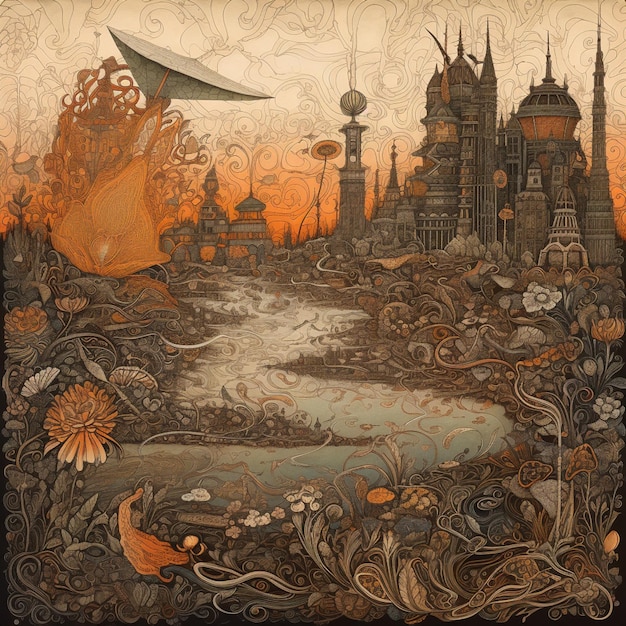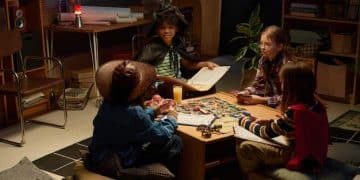Historical Fiction’s Accuracy: Evaluating Authenticity in Novels

Historical fiction’s accuracy involves assessing how well a novel integrates verifiable historical details, cultural contexts, and authentic representations of past events to create a believable and educational narrative for readers.
Historical fiction transports readers to different eras, but how do we assess the historical fiction’s accuracy: evaluating the authenticity of recent historical fiction novels in portraying the past? Let’s delve into this subject of evaluating the past.
Understanding Historical Fiction’s Authenticity
Historical fiction holds a unique place in literature, blending imaginative storytelling with real historical events. However, the question arises: How accurately do these novels portray the past? Understanding the balance between narrative and historical accuracy is crucial for readers.
Defining Historical Fiction
Historical fiction is a genre that places fictional characters and plots within a historically authentic setting. The aim is to recreate a realistic portrayal of a particular period, making the reader feel immersed in the past.
Importance of Authenticity
While it’s fiction, authenticity is key. Accuracy lends credibility to the story and enhances the reader’s experience, making the past more tangible. It can also educate readers about historical events and cultural contexts.

Let’s explore key aspects that contribute to the authenticity of historical fiction:
- Historical Details: Accurate dates, events, and figures.
- Cultural Context: Realistic depiction of social norms, values, and daily life.
- Language: Use of language and diction appropriate to the period.
By understanding these elements, readers can better evaluate the authenticity of the historical narratives they encounter. It’s about striking a balance between entertainment and education, ensuring that the past is respected and accurately represented.
The Author’s Role: Balancing Fact and Fiction
The author of historical fiction takes on a considerable challenge: merging factual historical events with imaginative storytelling. This balancing act requires thorough research, keen attention to detail, and an understanding of how to weave historical elements seamlessly into the narrative.
Extensive Research
Authors must delve deep into the historical period they are writing about. This involves consulting primary sources, academic research, and expert opinions to gain a comprehensive understanding of the era.
Creative License
While accuracy is essential, authors are also storytellers. They use creative license to develop characters, create plotlines, and fill in gaps in the historical record.
Authors consider these choices when blending history with fiction:
- Character Development: Fictional characters that act within the norms of the time.
- Plot Integration: Invented storylines that realistically fit within historical events.
- Filling the Gaps: Using imagination to complete incomplete historical narratives.

The author’s role is to create a believable world, and this involves making informed decisions about where to adhere strictly to the historical record and where to diverge for the sake of the story. It’s a delicate balance that, when done well, can bring history to life in a compelling way.
Evaluating Accuracy: Key Elements to Consider
When evaluating the accuracy of historical fiction, consider several key elements that contribute to the authenticity of the narrative. These elements range from the portrayal of historical figures to the depiction of daily life, and they all play a crucial role in creating a believable and immersive experience for the reader.
Portrayal of Historical Figures
The depiction of real historical figures should align with known facts and accepted interpretations. It’s essential that their actions and motivations are consistent with what is documented.
Details of Daily Life
Authentic historical fiction pays attention to the mundane aspects of life, such as clothing, food, customs, and social norms. These details help ground the story in its historical setting.
Language and Dialogue
The language should reflect the dialect and speech patterns of the time period. While it’s not always possible to perfectly replicate historical language, the dialogue should feel appropriate for the characters and setting.
Readers can evaluate the fiction by considering aspects like:
- Realistic Interactions: Characters interacting in ways consistent with social hierarchies.
- Period-Appropriate Settings: Descriptions that match archaeological and historical records.
- Consistent Tone: A narrative voice fitting the era.
Accuracy in historical fiction is not just about getting the big events right; it’s about capturing the essence of a time period through a multitude of small, well-researched details.
Case Studies: Recent Historical Fiction Novels
Examining specific recent historical fiction novels can provide insight into how authors handle the challenges of accuracy and authenticity. By comparing different approaches and assessing the strengths and weaknesses of each, we can better understand what makes for compelling and reliable historical fiction.
“The Nightingale” by Kristin Hannah
Set in France during World War II, “The Nightingale” follows two sisters and examines the role of women in the French Resistance. While praised for its emotional depth and compelling narrative, some critics have noted minor inaccuracies in the depiction of specific events.
“Hamnet” by Maggie O’Farrell
“Hamnet” reimagines the life of William Shakespeare’s son and the family dynamics of the time. The novel is celebrated for its evocative portrayal of the Elizabethan era, although it takes some creative liberties with historical timelines and personal details.
Analyses highlights these key areas:
- Critical Reception: Reviews from historians and literary critics.
- Reader Feedback: Comments on historical accuracy and narrative impact.
- Author Commentary: Insights from authors on their research and creative decisions.
By exploring a range of novels and their strengths and weaknesses, readers can develop their own criteria for evaluating historical fiction. It’s about appreciating the author’s effort to bring the past to life while maintaining a critical eye for accuracy.
Common Pitfalls: Where Historical Fiction Often Fails
While many authors strive for accuracy, historical fiction often falls short in several common areas. Recognizing these pitfalls can help readers critically assess the authenticity of the novels they read and understand the complexities of representing the past.
Anachronisms
One of the most common mistakes is the inclusion of anachronisms—details or elements that are out of place in the historical context. This can range from using modern language to depicting technologies or customs that did not exist at the time.
Stereotypes and Misrepresentations
Historical fiction can perpetuate harmful stereotypes or misrepresent certain groups or cultures. This can occur when authors rely on outdated or biased sources or when they fail to fully understand the nuances of the historical period.
Ignoring the Nuances
Failing can happen in these areas, too:
- Oversimplification: Reducing complex social issues to simple narratives.
- Lack of Context: Presenting events without the necessary background information.
- Imposing Modern Values: Judging historical figures by contemporary standards.
Avoiding these issues requires extensive research, cross-referencing sources, and sensitivity to historical context. Authors should strive to create a nuanced and accurate portrayal of the past, avoiding the temptation to simplify or sensationalize history.
Impact on Readers: Education vs. Entertainment
Historical fiction has a dual impact on readers, serving both as a source of entertainment and a potential educational tool. How readers engage with historical fiction and how they perceive its accuracy can have lasting effects on their understanding of the past.
Entertainment Value
Historical fiction can be incredibly engaging, transporting readers to different times and places. The thrill of experiencing history through the eyes of fictional characters can be both enjoyable and emotionally resonant.
Educational Potential
At its best, historical fiction can spark an interest in history and encourage readers to learn more about specific events, cultures, or time periods. It can also humanize historical figures and provide insights into the challenges and triumphs of the past.
The balance impacts readers in critical ways:
- Critical Thinking: Encourages readers to question historical narratives.
- Empathy and Understanding: Fosters a deeper appreciation of diverse cultures.
- Lifelong Learning: Ignites a passion for history.
Ultimately, the impact of historical fiction on readers depends on how well authors balance accuracy with narrative appeal. When done effectively, it can be a powerful tool for education and entertainment.
| Key Point | Brief Description |
|---|---|
| 🔍 Authenticity | Balance between narrative and historical fact verification. |
| ✍️ Author’s Role | Blend factual events with storytelling. |
| 🗓️ Evaluating Details | Examine figures, daily life & language accuracy. |
| 📚 Recent Case Studies | Analysis of “The Nightingale” and “Hamnet”. |
Frequently Asked Questions
Accurate historical fiction involves verifiable details, cultural contexts, and representations of past events woven into the narrative. The story becomes believable and offers an educational experience for readers.
Authors balance accuracy through extensive research and using creative license to develop characters and plotlines. Historical elements integrate seamlessly into the narrative by combining reality with a touch of imagination.
Common mistakes in historical fiction include anachronisms, where elements are out of place in their historical contexts. Other failures involve stereotypes, misrepresentations, or the absence of complex historical nuances.
Historical accuracy in fiction lends credibility to the storyline, enhances the experience for readers, and educates about specific events and cultural contexts. Plus, the result provides an immersive and informative narrative.
While creative license allows authors to develop fictional elements within an historical setting, it can impact accuracy if not properly balanced. Inventing storylines should align with historical events to avoid misrepresentation.
Conclusion
In conclusion, the appeal of historical fiction lies in its ability to transport us to different times and places, offering both entertainment and education. The degree to which these novels accurately portray the past depends on the author’s commitment to research, attention to detail, and skillful integration of fact and fiction.





